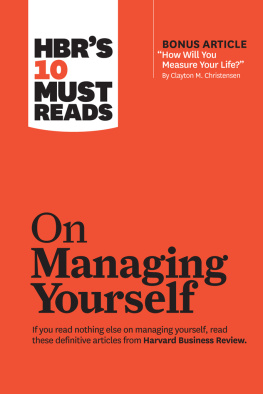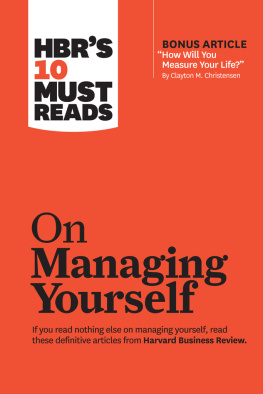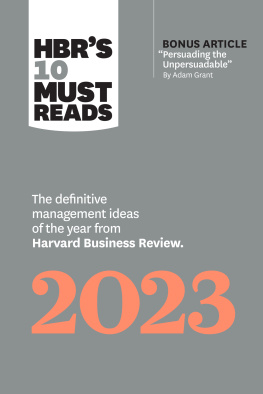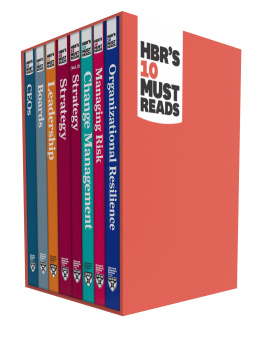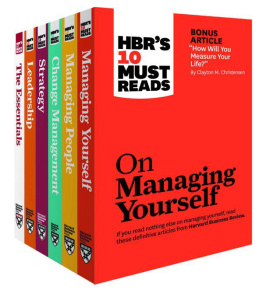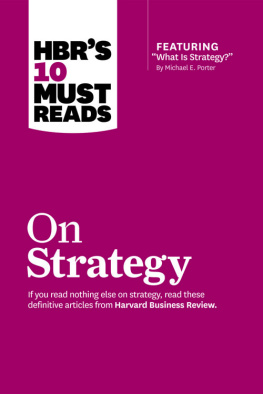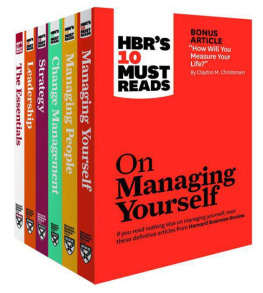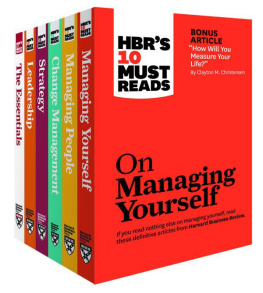Harvard Business Review - HBRs 10 Must Reads Ultimate Boxed Set
Here you can read online Harvard Business Review - HBRs 10 Must Reads Ultimate Boxed Set full text of the book (entire story) in english for free. Download pdf and epub, get meaning, cover and reviews about this ebook. year: 2017, publisher: Lightning Source Inc, genre: Business. Description of the work, (preface) as well as reviews are available. Best literature library LitArk.com created for fans of good reading and offers a wide selection of genres:
Romance novel
Science fiction
Adventure
Detective
Science
History
Home and family
Prose
Art
Politics
Computer
Non-fiction
Religion
Business
Children
Humor
Choose a favorite category and find really read worthwhile books. Enjoy immersion in the world of imagination, feel the emotions of the characters or learn something new for yourself, make an fascinating discovery.
- Book:HBRs 10 Must Reads Ultimate Boxed Set
- Author:
- Publisher:Lightning Source Inc
- Genre:
- Year:2017
- Rating:5 / 5
- Favourites:Add to favourites
- Your mark:
- 100
- 1
- 2
- 3
- 4
- 5
HBRs 10 Must Reads Ultimate Boxed Set: summary, description and annotation
We offer to read an annotation, description, summary or preface (depends on what the author of the book "HBRs 10 Must Reads Ultimate Boxed Set" wrote himself). If you haven't found the necessary information about the book — write in the comments, we will try to find it.
Harvard Business Review: author's other books
Who wrote HBRs 10 Must Reads Ultimate Boxed Set? Find out the surname, the name of the author of the book and a list of all author's works by series.
HBRs 10 Must Reads Ultimate Boxed Set — read online for free the complete book (whole text) full work
Below is the text of the book, divided by pages. System saving the place of the last page read, allows you to conveniently read the book "HBRs 10 Must Reads Ultimate Boxed Set" online for free, without having to search again every time where you left off. Put a bookmark, and you can go to the page where you finished reading at any time.
Font size:
Interval:
Bookmark:
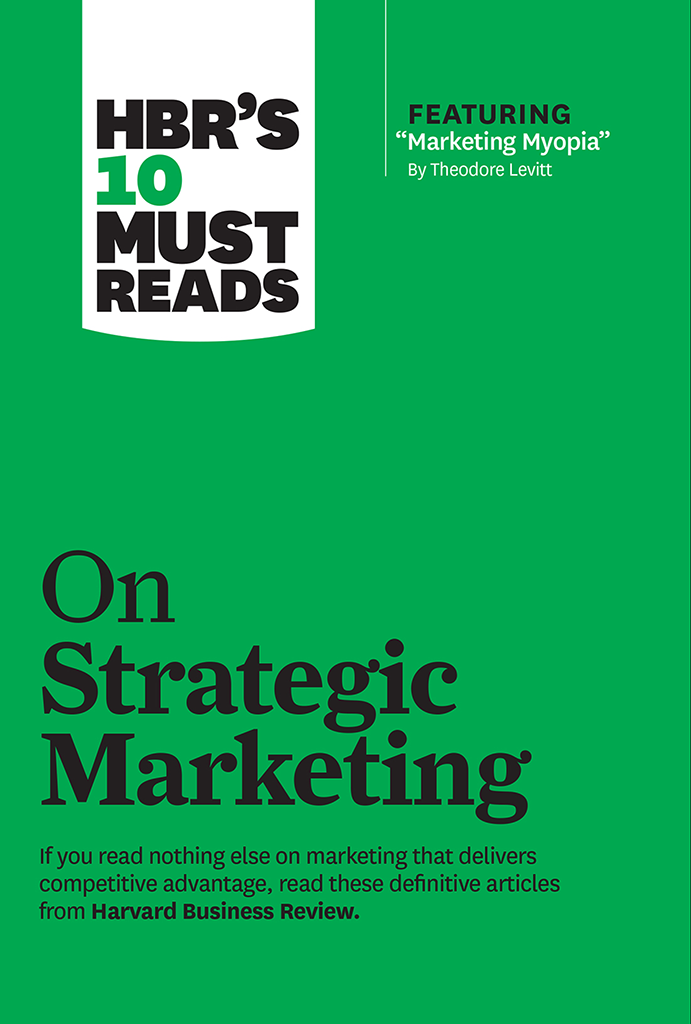
HBRs 10 Must Reads series is the definitive collection of ideas and best practices for aspiring and experienced leaders alike. These books offer essential reading selected from the pages of Harvard Business Review on topics critical to the success of every manager.
Titles include:
HBRs 10 Must Reads 2015
HBRs 10 Must Reads 2016
HBRs 10 Must Reads 2017
HBRs 10 Must Reads for New Managers
HBRs 10 Must Reads on Change Management
HBRs 10 Must Reads on Collaboration
HBRs 10 Must Reads on Communication
HBRs 10 Must Reads on Emotional Intelligence
HBRs 10 Must Reads on Innovation
HBRs 10 Must Reads on Leadership
HBRs 10 Must Reads on Making Smart Decisions
HBRs 10 Must Reads on Managing Across Cultures
HBRs 10 Must Reads on Managing People
HBRs 10 Must Reads on Managing Yourself
HBRs 10 Must Reads on Sales
HBRs 10 Must Reads on Strategic Marketing
HBRs 10 Must Reads on Strategy
HBRs 10 Must Reads on Teams
HBRs 10 Must Reads: The Essentials
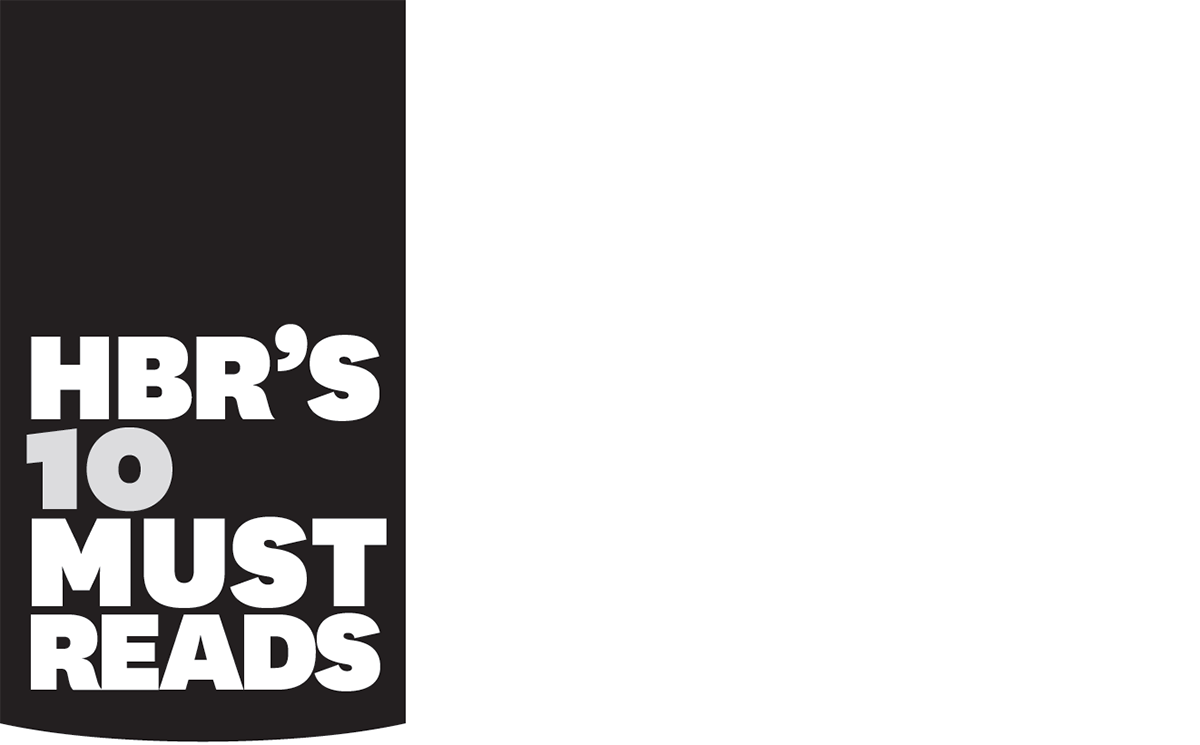
On
Strategic Marketing
HARVARD BUSINESS REVIEW PRESS
Boston, Massachusetts
Find more digital content or join the discussion on www.hbr.org.
Copyright 2013 Harvard Business School Publishing Corporation
All rights reserved
No part of this publication may be reproduced, stored in or introduced into a retrieval system, or transmitted, in any form, or by any means (electronic, mechanical, photocopying, recording, or otherwise), without the prior permission of the publisher. Requests for permission should be directed to , or mailed to Permissions, Harvard Business School Publishing, 60 Harvard Way, Boston, Massachusetts 02163.
The web addresses referenced in this book were live and correct at the time of the books publication but may be subject to change.
Library of Congress Cataloging-in-Publication Data
HBRs 10 must reads on strategic marketing.
p. cm. (HBRs 10 must read series)
Includes index.
ISBN 978-1-4221-8988-7
1. MarketingManagement. 2. Strategic planning. I. Harvard business review. II. Title: HBRs ten must reads on strategic marketing. III. Title: Harvard business reviews 10 must reads on strategic marketing.
HF5415.13.H368 2013
658.8'02dc23
2012037855
eISBN: 978-1-4221-9152-1
Contents
Roland T. Rust, Christine Moorman, and Gaurav Bhalla
David C. Edelman
Theodore Levitt
Clayton M. Christensen, Scott Cook, and Taddy Hall
Kevin Lane Keller
Michael J. Silverstein and Kate Sayre
James C. Anderson, James A. Narus, and Wouter van Rossum
Susan Fournier and Lara Lee
Frederick F. Reichheld
Philip Kotler, Neil Rackham, and Suj Krishnaswamy
Rethinking Marketing
by Roland T. Rust, Christine Moorman, and Gaurav Bhalla
IMAGINE A BRAND MANAGER sitting in his office developing a marketing strategy for his companys new sports drink. He identifies which broad market segments to target, sets prices and promotions, and plans mass media communications. The brands performance will be measured by aggregate sales and profitability, and his pay and future prospects will hinge on those numbers.
Whats wrong with this picture? This firmlike too manyis still managed as if it were stuck in the 1960s, an era of mass markets, mass media, and impersonal transactions. Yet never before have companies had such powerful technologies for interacting directly with customers, collecting and mining information about them, and tailoring their offerings accordingly. And never before have customers expected to interact so deeply with companies, and each other, to shape the products and services they use. To be sure, most companies use customer relationship management and other technologies to get a handle on customers, but no amount of technology can really improve the situation as long as companies are set up to market products rather than cultivate customers. To compete in this aggressively interactive environment, companies must shift their focus from driving transactions to maximizing customer lifetime value. That means making products and brands subservient to long-term customer relationships. And that means changing strategy and structure across the organizationand reinventing the marketing department altogether.
Not long ago, companies looking to get a message out to a large population had only one real option: blanket a huge swath of customers simultaneously, mostly using one-way mass communication. Information about customers consisted primarily of aggregate sales statistics augmented by marketing research data. There was little, if any, direct communication between individual customers and the firm. Today, companies have a host of options at their disposal, making such mass marketing far too crude.
The exhibit shows where many companies are headed, and all must inevitably go if they hope to remain competitive. The key distinction between a traditional and a customer-cultivating company is that one is organized to push products and brands whereas the other is designed to serve customers and customer segments. In the latter, communication is two-way and individualized, or at least tightly targeted at thinly sliced segments. This strategy may be more challenging for firms whose distribution channels own or control customer informationas is the case for many packaged-goods companies. But more and more firms now have access to the rich data they need to make a customer-cultivating strategy work.
B2B companies, for instance, use key account managers and global account directors to focus on meeting customers evolving needs, rather than selling specific products. IBM organizes according to customer needs, such as energy efficiency or server consolidation, and coordinates its marketing efforts across products for a particular customer. IBMs Insurance Process Acceleration Framework is one example of this service-oriented architecture. Customer and industry specialists in IBMs insurance practice work with lead customers to build fast and flexible processes in areas like claims, new business processing, and underwriting. Instead of focusing on short- term product sales, IBM measures the practices performance according to long-term customer metrics.
Idea in Brief
Companies have never before had such powerful technologies for understanding and interacting with customers. Yet too many firms operate as if theyre stuck in the 1960s, an era of mass marketing, mass media, and impersonal transactions.
To compete in an aggressively interactive environment, companies must shift their focus from driving transactions to maximizing customer lifetime value. That means products and brands must be made subservient to customer relationships. And that means transforming the marketing departmenttraditionally focused on current salesinto a customer department by: replacing the CMO with a chief customer officer, cultivating customers rather than pushing products, adopting new performance metrics, and bringing under the marketing umbrella all customer-focused departments, including R&D and customer service.
Building relationships
Product-Manager Driven
Many companies still depend on product managers and one-way mass marketing to push a product to many customers.
Customer-Manager Driven
Whats needed is customer managers who engage individual customers or narrow segments in two-way communications, building long-term relationships by promoting whichever of the companys products the customer would value most at any given time.
Font size:
Interval:
Bookmark:
Similar books «HBRs 10 Must Reads Ultimate Boxed Set»
Look at similar books to HBRs 10 Must Reads Ultimate Boxed Set. We have selected literature similar in name and meaning in the hope of providing readers with more options to find new, interesting, not yet read works.
Discussion, reviews of the book HBRs 10 Must Reads Ultimate Boxed Set and just readers' own opinions. Leave your comments, write what you think about the work, its meaning or the main characters. Specify what exactly you liked and what you didn't like, and why you think so.

